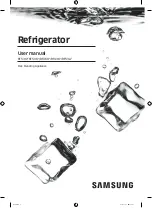
21
duce ice cubes and to freeze fresh food. The tem-
perature of the freezer is automatically controlled by
the temperature control in the fridge.
NOTE:
NOTE:
NOTE:
NOTE:
Make sure that the temperature in the freezer does
not rise above -18°C. For this, the unit should be
defrosted regularly. A thick frozen layer deteriorates
the cooling and increases the power consumption.
Freezing
Freezing
Freezing
Freezing
•
24 hours before freezing we recommend turning
the temperature control to the highest power level
and to keep this setting even after freezing for a
few hours. The appliance is not compromised if
the setting will not revert to a normal operating
temperature after the freezing process, but for
economic reasons you should possibly avoid it.
•
Fresh food should be frozen as fast as possible to
the core. Therefore during freezing operation, the
temperature of fresh food should be lowered as
fast as possible in order to keep formation of ice
crystals as little as possible and not to damage
the food structure.
•
Frozen food should be kept in contact with the
bottom of the compartment.
•
Keep a space between the individual items, so
that the cold air can circulate.
Storing frozen food
Storing frozen food
Storing frozen food
Storing frozen food
•
Packed frozen merchandise should be stored in a
4-star-freezer compartment in accordance with
the manufacturer’s data. Make sure the food
items do not defrost after purchase and to store
them as fast as possible in the freezer.
•
It is possible to store food for longer periods of
time, up to three months. This period might vary,
so observe the storage information on the pack-
aging of the merchandise.
General safety precautions
General safety precautions
General safety precautions
General safety precautions
•
Do not exceed the maximum freezing capacity.
See data under "EU Product Data Sheet” or on
the rating label.
•
Do not store bottles or cans. These can break
when the contents freeze – or even explode, if
they contain carbonated drinks.
•
Once products have been defrosted halfway or
completely, they should be consumed as soon as
possible and should not be frozen again, except
they have been processed to a ready meal.
•
Do not open the door in case of power failure. If
the failure does not take longer than 18 hours, the
food will not be affected.
•
Do not eat food that is still frozen. Do not eat ice
cream directly from the freezer. The cold can
cause injuries in the oral cavity.
•
Touching metal parts inside the appliance can
cause symptoms similar to burns if the skin is very
sensitive.
•
Never touch frozen food with moist or wet hands.
Operating noise
Operating noise
Operating noise
Operating noise
Type of sound
Type of sound
Type of sound
Type of sound
Cause
Cause
Cause
Cause
Mumbling
Compressor during its operation
Liquid sounds
Circulation of the refrigerant
Click sounds
The temperature control turns the
compressor on or off
Disturbing
noises
Vibration of the shelves or cooling
coils
Switching
Switching
Switching
Switching off
off
off
off
To switch off the appliance t
To switch off the appliance t
To switch off the appliance t
To switch off the appliance turn the temperature
urn the temperature
urn the temperature
urn the temperature co
co
co
con-
n-
n-
n-
trol
trol
trol
trol to
to
to
to the off state.
the off state.
the off state.
the off state.
If the appliance is out of use for long periods:
•
Remove the appliance content.
•
Disconnect the appliance from the power supply.
•
Clean the appliance thoroughly (see ”Cleaning
and Maintenance”).








































